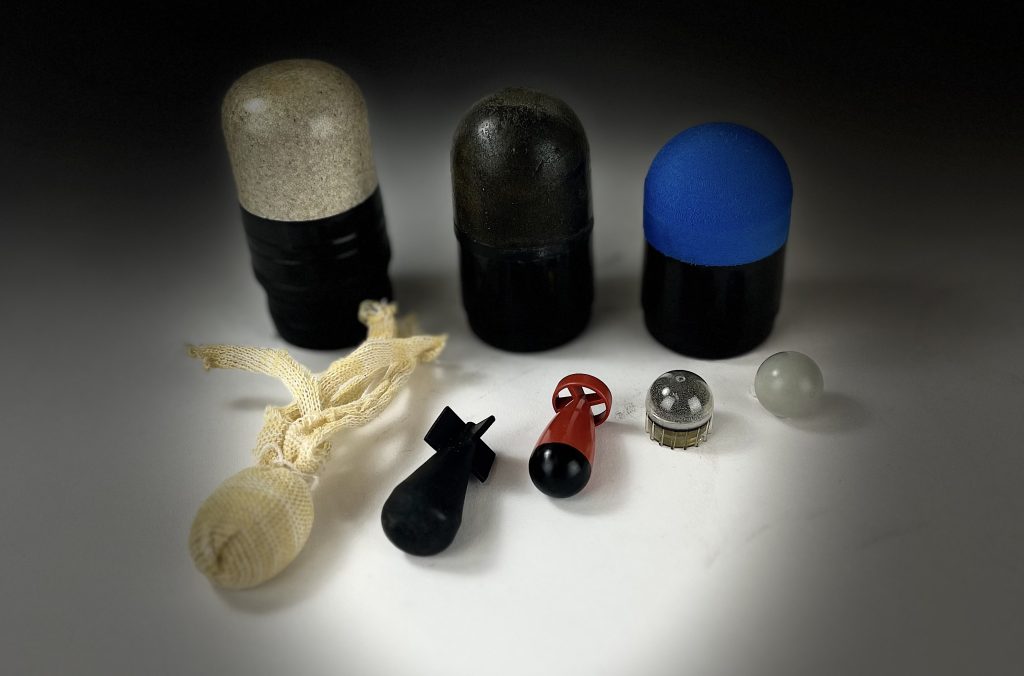
Navigating modern law enforcement, military and security engagements requires an increasingly complex understanding of the risks of lethality, as well as the chance for long-term harm to those targeted by weapons deployment. The deployment of lethal force, whether by deploying a firearm, physical strikes, or other measures, is expected to be a last resort during engagements, with less lethal and “non-lethal” measures being intended to mitigate and reduce the chance of severe harm inflicted upon targets wherever possible.
To uphold this intention, it is vital to have a thorough and reliable understanding of both the blunt force trauma potential of a non/less lethal round, as well as how this potential varies given a wide range of factors like distance, environmental factors, target location, etc. It is also crucial to understand that while the terms “less” and “non” lethal may be used interchangeably when referring to certain kinds of ammunition and weaponry, there are distinct differences in what each term implies, as well as their potential outcomes when deployed.
Biokinetics is proud to be one of North America’s most trusted teams for blunt force trauma testing, as well as ballistic evaluation, to help empower law enforcement, military and related fields to utilize necessary tools with the appropriate knowledge to minimize bodily harm done to all parties.
Below, we’ll take a closer look at some of the core distinctions to be aware of in the discourse regarding “less” and “non” lethal ammunition. Read on to learn more.
Addressing a Dangerous Misconception
Before we delve into the specific difference between less lethal and non-lethal ammunition, it’s vital to state that, in real-world applications, there is no such thing as completely non-lethal ammunition or use of force. The reality is the use of any kind of force and the kinetic transfer of that force, whether projectile or otherwise, may result in a fatality or significant bodily harm. This is why it is so vital to understand a projectile or weapon’s innate threshold for harm. Blunt force trauma testing and ballistic analysis are essential to allowing regulators, manufacturers and operators to create and implement standardized practices designed to reduce the potential for serious injury or death while still applying necessary measures in extreme situations where no other option is viable.
This allows regulators, manufacturers and operators to create and implement standardized practices. With this in mind, let’s examine the key differences between less lethal and “non-lethal” rounds.
Less Lethal Ammunition
Less lethal ammunition is designed to be deployed in highly contentious engagements where combatants or individuals have reached a point where it is reasonable to assume that de-escalation and/or the removing an inherent risk to others is only possible through the use of significant force. Less lethal rounds may result in serious injuries or, in extreme cases, fatalities, but are designed to reduce the risk of this occurring significantly in comparison to standard, lethal rounds.
Less lethal ammunition, such as rubber bullets and bean bag rounds, are often used for crowd control and fit within this category. In such cases, while the intent is to cause a strong impact as a form of deterrence, rounds are not meant to penetrate the skin or be targeted at vulnerable areas that are more susceptible to severe harm from blunt force trauma. Less lethal ammunition typically has lower kinetic energy compared to lethal rounds and is designed to disperse energy upon impact to minimize tissue damage. The materials used, including rubber and soft polymer, are more flexible, and rounds are fired from specialized launchers or adapted firearms that control the velocity and spread of the ammunition for reduced harm upon impact.
“Non-Lethal” Ammunition
Non-lethal ammunition is similarly intended to incapacitate or deter without causing death or serious injury but refers to a broader category of methods and/or tactics than typically anticipated or discussed. The expectation with non-lethal tools and tactics is that it should not result in fatalities or permanent harm if they are used correctly, where the potential for significant bodily harm is more readily anticipated with the use or deployment of less lethal methods.
Methods and tools that fall within the scope of this category include paintball rounds, Oleoresin Capsicum (OC) spray, sonic weapons that disorient crowds, and the deployment of soft foam projectiles. Non-lethal rounds utilize even lower kinetic energy than less lethal rounds and are specifically designed to lower the threshold for harm. As such, the materials used, as well as delivery methods are scaled to specifications that are less likely to result in bodily injury.
The Importance of Appropriate Ammunition Selection and Risk-Threshold Evaluation
Selecting the appropriate type of ammunition is crucial for achieving the desired balance between efficacy and safety. In law enforcement, military, and security contexts, the choice between less lethal and non-lethal ammunition can determine the outcome of an encounter and its aftermath.
To understand the best methods of usage, as well as the inherent risk of application, extensive blunt force trauma and ballistics testing is essential. The data gathered through tests conducted by leading teams like Biokinetics helps to provide invaluable insights into the appropriate and most effective use of both non and less-lethal ammunition/methods of deterrence and to help pave a better way forward for operators and civilians/combatants exposed to the use of force. Learn more about Biokinetics’ extensive less-lethal testing services by contacting our team today!

